India and China- Two superpowers of South asia are face to face once again
You have surely heard about the border disputes between India and China. Tensions between India and China are not a new phenomenon. Such disputes have often occurred in the past as well. However, the intensity of the dispute is slightly higher this time. China is creating new disputes accusing the Indian Army of crossing the LAC(Line of actual control). While Chinese troops have damaged the Galwan post and bridge of Chang Chenmo, disrupting normal patrolling, along the Indian border. This LAC dispute is old, but the recent incursions by China are not just border violations. Nor should it be seen as a show of strength, it has a deep gait behind it. China is increasing tensions within the Indian border in anger for several reasons. In fact, China has been troubled since the removal of Sections 370 and 35A and reorganization of Jammu and Kashmir with declaration of Ladakh as a Union Territory and has also raised the issue in the UNSC(The United Nations Security Council). The COVID-19 epidemic has tarnished China's image. His economy has collapsed. Foreign companies originating from China are seeing India as a better option for investment. India's close proximity with the US and strategic alliances with countries such as China's anti-Japan has made China sleepless. China is seeing an advantage in destabilizing India. China can demolish India's dream of becoming an industrial hub. China has been badly hit by many countries, including the US, after border disputes with many neighboring countries Taiwan, Hongkong, Vietnam. Despite such problems, China still wants to dispute with India.
Where are the disputes of China with India-
India shares 3,488 km border with China. The border passes through Jammu and Kashmir, Himachal Pradesh, Uttarakhand, Sikkim and Arunachal Pradesh. It is divided into three sectors. Western sector i.e. Jammu and Kashmir, Central sector i.e. Himachal Pradesh and Uttarakhand and Eastern sector i.e. Sikkim and Arunachal Pradesh. There are border disputes between the two countries over many of these areas. The recent confrontation is the result of the same controversy. Even before this, the armies of both countries have come face to face with border violations. Due to the border dispute, there was a war between the two countries in 1962.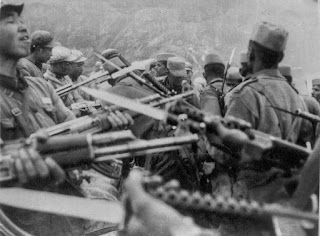 |
| 1962, war between India and China |
Aksai Chin:
China's first claim on the Indian border area is Aksai Chin. William Johnson in 1865 proposed a demarcation of borders in 1865 known as the “Johnson Line” that puts the region of Aksai Chin in Indian territory. After India gained independence in 1947, it considered Johnson Line as the basis for its official boundary in the region and considered the region to be a part of India, but this region is occupied by China. From the latter part of the occupation, China considers the Indian border. In the 1962 war, China occupied the Aksai Chin region of India. Since then, this area has been a cause of dispute between the two countries. Strategically, this area has a great importance.
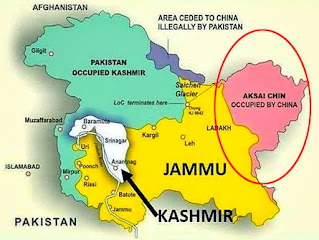 |
| Area occupied by China- Aksai Chin |
Arunachal Pradesh:
China calls many areas including Tawang in Arunachal Pradesh as its own and calls them a part of southern Tibet. In 1954, India formed the North East Frontier Agency, which was later recognized as Arunachal Pradesh. But China refused its recognition. Tawang is also a major pilgrimage center for Buddhists, which is why when the Dalai Lama visited the region, there was strong opposition from China. Not only this, China has been opposing the visit of anyone in this area and any kind of construction work to be done here.
Pangong Tso Lake:
This 135 km long lake between India and China is located at an altitude of more than 14,000 feet. An area of 45 km of this lake lies in India and 90 km in China. Many times Indian and Chinese soldiers have also come face to face on this lake. Strategically, this lake is important because it is also the Chushul Valley from where China can invade Indian territory. In the war of 1962, China started the attack from here. There are also reports that China has been constructing roads in its area of Pangong Tso from some time.
Sikkim:
In the referendum conducted by the state of Sikkim in the year 1975, people voted in favor of merger with India. Thus Sikkim became part of India, but China again refused to accept it. China also calls many areas of Sikkim of its own territory.
 |
| Map showing all disputed lands between India and China |
China-Pak Economic Corridor (CPEC):
The China-Pak Economic Corridor (CPEC) is also a major issue of dispute between India and China. The CPEC One Belt One Road (OBOR) covers a number of infrastructure projects, which are being developed in collaboration with China and Pakistan from 2013. These projects include highway and railway, APG and many projects including pipeline networks for gas transport. The project was announced by Chinese chief Xi Jinping during his visit to Pakistan in 2015. These billions of billion dollar projects are aimed at the commercial interests of both countries. CPEC may be a China-Pak project, but India has serious objections about it. The objection is due to the passing of these projects through Pakistan occupied Kashmir(Pok). India believes that the use of PoK for CPEC is to interfere with India's supremacy. This is why India has boycotted and not participated in the OROB conference in held China, which was attended by many countries of the world. India's absence in this conference is also a reason for China's displeasure.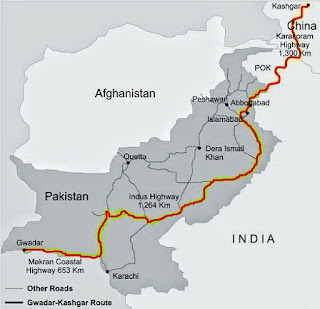 |
| CPEC |
The Line of Actual Control(LAC) between India and China:
The Line of Actual Control currently borders China and India. This line separates the Indian territory and Aksai Chin occupied by China. The LAC differs from the Line of Control set by Sir Vincent Arthur
Henry McMahon. In 1962, Aksai Chin was captured by China in the war between the two countries. After the ceasefire, the border between the two countries was considered after the part occupied by China, it is called LAC. The LAC passes through Ladakh, Kashmir, Uttarakhand, Himachal Pradesh, Sikkim and Arunachal Pradesh.
 |
| Sir Henry McMahan |
McMahan line :
The division between India and China determines the McMahon Line, but China refuses to consider it a border line. The demarcation of the border between India and China took place at a conference held in Shimla in 1913–14 in the presence of representatives of China, Tibet and Britain. At this conference, Sir Henry McMahon, the contemporary foreign secretary of British India, laid a 550-mile-long border line between British India and Tibet. This line was accepted by the current Tibet and British representatives. In this way, Tawang and other areas of Tibet came under the imperial British Empire. But the representative of China refused to consider the McMahon Line as the boundary line between the two countries. At that time, China had claimed that its territory is as far as the border of Assam, since then there has been a border dispute between China and India. China argues that it was not involved in the agreement between the representatives of Tibet and British India at the time of demarcation of the border. Since Tibet is part of China, the agreement reached by it has no significance.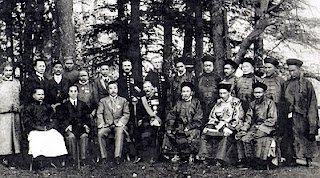 |
| Tibetan, British and Chinese participants in the Shimla Treaty in 1913-14 |
What is Doklam controversy?
In 2017, there was a lot of dispute between India and China over the road construction by China in Doklam, a plateau area. Along with Bhutan, India also objected to this move of China. After stiff opposition from India, there was a deadlock in this area for 73 days and the forces of China and India stood face to face here. Actually, there has been a dispute between China, India and Bhutan over this area for years. Doklam, popularly known as Donglong in China, lies between India, Tibet and Bhutan and is also the meeting point of the three countries. The area is controlled by China, but Bhutan also asserts its claim and India supports Bhutan. The region is also a part of the northeastern state of India, Sikkim. There was a written agreement between China and Bhutan regarding this disputed area, which is documented by Bhutan, according to which, till the final resolution of this border dispute is reached, peace will have to be maintained here. However, in this case China says that the 1890 agreement mentions the Sikkim portion of the India-China border. According to this agreement, the Sikkim portion of the India-China border starts from Mount Gipamochi in the east. China claimed that Indian troops entered illegally within two kilometers of Mount Gippamochi in the Sikkim region, while India had nothing to do with that part.Importance of Doklam :
Doklam is not just a disputed region, but holds strategic importance for both India and China. The disputed region is more important to India as it plays a key role in securing the Siliguri corridor in West Bengal, which connects Northeast India and the rest of Nepal to Bhutan, and is a part of the Chambal Valley. Located at a distance of 100 kilometers. For this reason, this corridor is also considered very sensitive, in some places the corridor is only 17 km wide. Due to its slim shape and sensitivity, this corridor is called the 'Chicken's Neck' of India. Doklam provides an easy way to build a road for China to reach the Bhutan border outpost. Where is Chumby Valley? The Chumbi Valley is just 50 km from the Siliguri Corridor and connects Bhutan, India and China. In this valley, two important passes of both countries, Nathula Pass of Sikkim and Jelap La Pass of China open. This valley is important for China because of its border with Tibet and Sikkim. This valley holds great importance not only for India's strategic interests, but also for the internal system. The Siliguri Corridor is just below the Chasbandi valley. |
| Doklam map |
Conclusion:
Right now, China faces challenges of charges of not providing timely information about Coronavirus and trade incredulity and imbalance. The question is that despite this, why is China intent on doing provocative actions? One reason is that the Chinese government, surrounded by all-round difficulties, wants to appease its citizens by showing that it has increased the pressure on India and its dominance in this area. But he should also understand that India will not tolerate this and he has shown this in the Doklam controversy. China should also not ignore that India is its largest trading partner after the US and the ASEAN(Association of Southeast Asian Nations) group. If China wants to get out of the current economic crisis, it will also need India's cooperation.
Just as India has adopted a defense strategy against Pakistan, similarly we will have to prepare on a large scale against China. Our preparedness is bound to be interrupted after the COVID-19 epidemic. We have put our whole heart and mind on Pakistan. This is also China's policy. Pakistan is doing what China should do. Solid preparation against China is necessary at various levels. India should immediately be active at the diplomatic level against the problems posed by China in Ladakh and instruct China to desist from such activities.
"It is not the India of 1962 that you will scare us and we will be scared."
Thanks for reading.
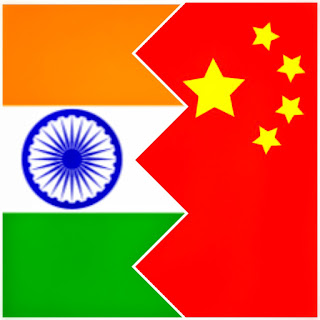







2 Comments
🐯🐯🐯🇮🇳🇮🇳🇮🇳
ReplyDeleteJai Hind🇮🇳🇮🇳
DeletePlease don't enter any spam link in the comment box.